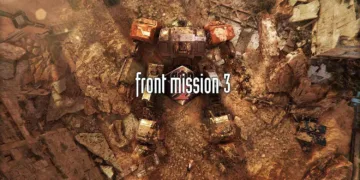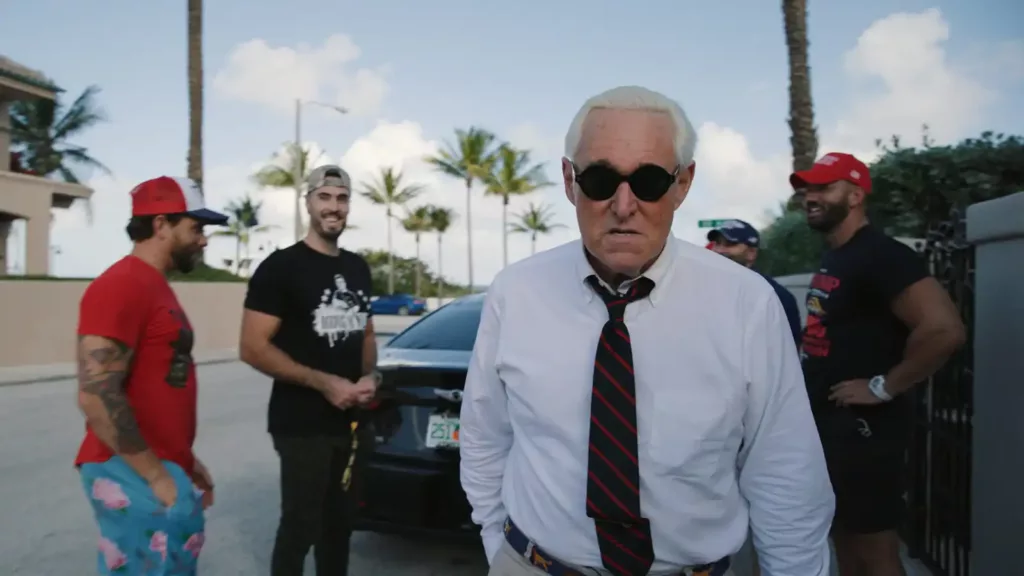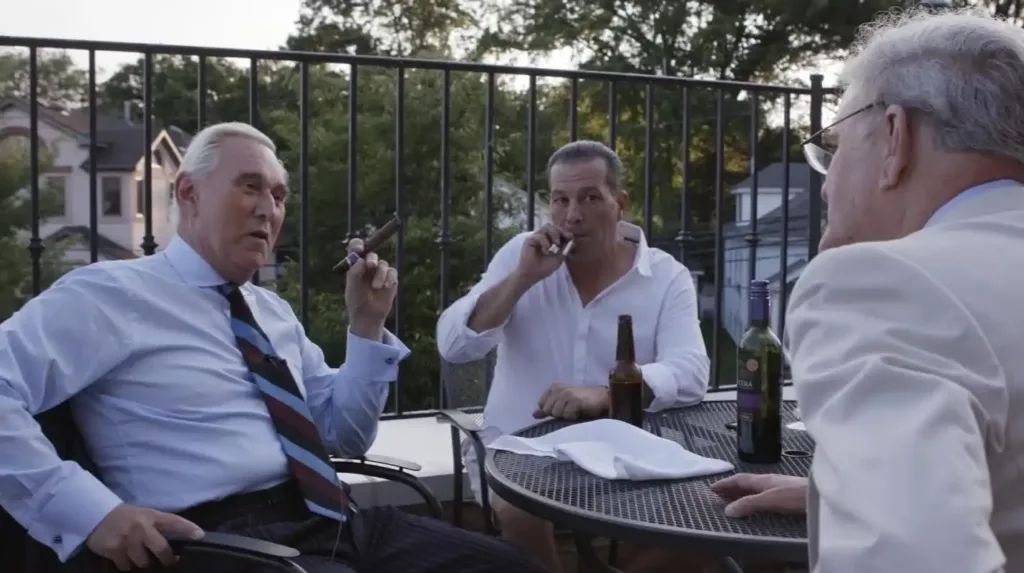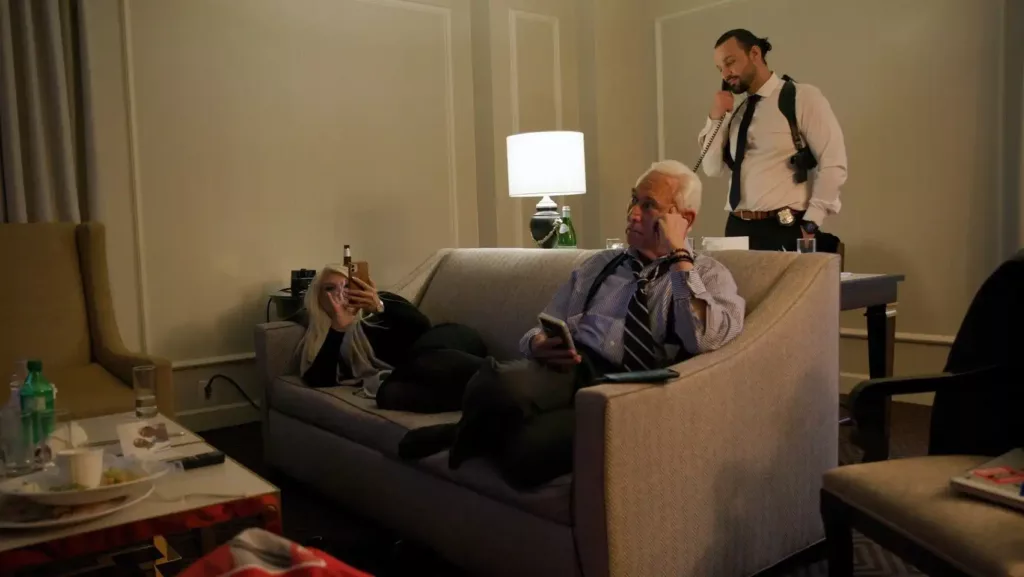Christoffer Guldbrandsen’s documentary A Storm Foretold takes a look inside the political machinations of Donald Trump’s long-time adviser, Roger Stone. Over the course of three years, from Stone’s 2019 indictment through the aftermath of the 2020 election, Guldbrandsen’s cameras follow the infamous “dirty trickster” as political tensions mount in America.
Stone made his career by pushing boundaries and playing hardball in GOP politics. As an outside consultant, he advised Republicans on impactful, though sometimes underhanded, strategies. This approach served him well for decades, but it also attracted many critics. By the time of Trump’s 2016 campaign, Stone had developed a reputation as one of Washington’s most controversial figures. His no-holds-barred style helped engineer Trump’s surprise victory, yet it also put him on a collision course with the law.
The film profiles Stone as the Russiagate investigation ensnares him and several key Trump allies. Despite facing felony charges, Stone remains an active player in conservative circles. With Trump in the White House, he continues advising the president and pushing a defiant message to supporters. As 2020 approaches, Stone takes point on coaching “Stop the Steal” efforts to dispute an election loss. Guldbrandsen captures the strategist devoted to gaining and maintaining influence through any means, even if it threatens the integrity of America’s democracy.
With unprecedented behind-the-scenes access, A Storm Foretold offers a revealing look at the darkness at the heart of America’s cultural wars. The documentary aims to shine a light on how disruptive personalities like Stone fan the flames of division for political gain, with consequences for society at large. By following the events as they unfold, Guldbrandsen brings an up-close view of an operation usually hidden from the public eye.
Behind the Scenes with a Political Provocateur
One of the most fascinating things about A Storm Foretold is the level of access filmmaker Christoffer Guldbrandsen gains with his controversial subject, Roger Stone. Over three transformative years, Guldbrandsen shadows Stone closely with a camera in hand. We see raw, unscripted moments as major events are still unfolding. Stone also sits for lengthy interviews, openly discussing his schemes and mindset.
This degree of behind-the-scenes observation is rare in the political world. Stone is notoriously private, so what compelled him to participate? It seems he saw value in controlling his own narrative. Yet the unbridled access allows uncomfortable truths to emerge accidentally. Stone frequently badmouths or contradicts himself without filters.
Guldbrandsen also struggles to maintain Stone’s trust at times. When Stone abandons the project midway for monetary reasons, it sends the filmmaker into a tailspin. His health suffers as a result of the intense process. This reveals the personal toll of getting so close to destructive forces in search of truth.
The filmmaker’s steady, observational presence provides crucial context. But his narration and private reflections occasionally distract from Stone’s unguarded moments. Guldbrandsen’s discomfort around his subject is palpable at points too, raising ethical questions about their dynamic.
While not all techniques strike the perfect tone, A Storm Foretold gives fleeting insight we’d rarely see otherwise into the ugly machinations of power politics. Both men play parts in this risky dance, with American democracy hanging in the balance. Their imperfect yet dogged pursuit of accountability leaves us still grappling over the aftermath of history in the raw.
The Man Behind the Spectacle
Christoffer Guldbrandsen grants unprecedented access to one of America’s most outrageous political operatives, Roger Stone. Over several transformative years, Stone makes no attempt to cloak his actions or moderate his behavior before cameras. The result is a vivid portrait of a man who is fundamentally comfortable with confrontation.
Stone relishes opportunities to antagonize perceived opponents. He mocks Guldbrandsen’s nationality and delays cooperation to extract better financial terms. While these tactics undermine credibility, they ring true to Stone’s history. His crude references and extreme rhetoric also energize dedicated followers.
Yet Stone simultaneously craves validation. He preens when name-dropping allies like Donald Trump or brags of close advisory roles. We see him strategize attention-grabbing performance pieces, from racy song appearances to provocative clothing. Even casual remarks imply a need for attention and influence beyond the real power held.
Stone likewise cultivates dependent relationships. His treatment of the Proud Boys resembled a dysfunctional friendship—demanding loyalty but scornfully dismissing individual members. After the 2020 election, disavowal by Trump leaves Stone briefly unmoored, hysterically lashing out in private moments.
Guldbrandsen’s nearness traces these conflicting desires. We observe a combative egotist who is intensely image-focused yet strangely insecure when stripped of tools to intimidate or attract attention. His political exploits fuel polarization but also reflect a self-seeking purpose through disruption rather than policy impact.
The film offers neither defense nor prosecution, letting Stone’s unvarnished actions and shifting alliances speak for themselves. While many question such access, it reveals complex truths about a man who so skillfully plays a provocative part yet remains desperate for applause and connection beneath the spectacle.
Behind closed doors
Christoffer Guldbrandsen’s documentary provides alarming insights into key political events through unprecedented access to Roger Stone. Viewers are given a front-row seat as Stone navigates the turmoil surrounding Donald Trump’s rise and fall from power.
The film offers a behind-the-scenes look at Trump’s controversial 2016 campaign, under fresh investigation for Russian interference. Precariously positioned at the center of accusations, we see Stone working tirelessly to undermine the probe. His tactics become clear as plans for election disruption take shape.
Most chilling are Stone’s preparations, as Trump’s defeat seemed imminent. Mic’d up without caution, he casually discusses initiating violence to contest results. We watch aggression and misinformation sow division, reaching a violent crescendo on January 6th. Though not alone in fueling this attack, Stone’s role is placed in sharp focus.
By being embedded within Stone’s inner circle, Guldbrandsen also sheds light on the fickle nature of political alliances. Stone’s shifting loyalties and eventual feud with Trump peel back layers of their complex relationship. We see firsthand how vulnerable allies can become when convenience ends. The film highlights flaws within a system that some seek to exploit.
While shocking at the moment, these scenes have also taken on historical significance. They provide primary source material for understanding events with lasting consequences. By offering an intimate view of Stone operating unchecked, the documentary plays an important part in the ongoing process of truth and accountability.
Through it all, Guldbrandsen maintains distance, neither endorsing nor attacking his subject. This impartial lens leaves judgment to viewers, arming them with more tangible insights into powers that can still shape our world today.
Questioning Authority
Christoffer Guldbrandsen’s film raises pressing concerns about ethics in politics and the impacts of misinformation. Throughout the documentary, Roger Stone displayed deeply disturbing tactics with little regard for consequences.
Time and again, Stone was caught spreading baseless conspiracy theories to manipulate audiences. From concocting falsehoods about the 2016 election to fabricating allegations of voter fraud in 2020, his strategies intentionally sowed division and panic. We see firsthand how such deceit fueled extremism and violence on that fateful day in January.
Those most vulnerable to influence, like proud Trump supporters chanting Stone’s innocence, faced the greatest harm from these deceptions. Their trust was exploited to undermine free and fair democratic processes. While Stone laughed all the way to the bank, it was everyday citizens who ultimately paid the highest price.
Yet the film questions whether there are real repercussions for strategists who so blatantly mislead the public. In spite of criminal charges, Stone continued spreading disinformation with apparent impunity. The commutation of his sentence and his presence at recent political events raise troubling doubts about accountability.
If dangerous untruths cannot be credibly punished, are there oversight measures that could help curb the toxic impacts of dark money and disinformation in our system? The film leaves us wondering how political actors might be reasonably constrained from intentionally endangering democracy and the most vulnerable in society.
Overall, Guldbrandsen’s unflinching look forces a reconsideration of ethical rules within politics and political consulting. In questioning one man’s slippery behavior, it compels us to examine the larger structures that could enable accountability for protecting the public good over personal gain.
Capturing Controversy
Christoffer Guldbrandsen’s up-close access to Roger Stone yields revealing footage, but the documentary’s effects are mixed. Through Guldbrandsen’s lens, we view uncomfortable interactions that expose Stone’s reckless conduct. Hidden audio of supposed “off-record” comments proves particularly illuminating.
Witnessing such unfiltered moments as Stone’s threats toward the filmmaker or casual incitement of violence keeps viewers on edge. Yet this rawness also challenges the story’s coherence at times. With no overt narration to frame chaotic scenes, their meaning risks getting lost.
Tension abounds when Stone retreats from the project, leaving Guldbrandsen in limbo with only reflections to fill the void. But more could have been done to profoundly understand their uneasy ties. Similarly, extended scenes of Stone scheming behind closed doors strengthen the film’s arguments, though some conversations seem to abruptly end before resolution.
Overall, Guldbrandsen takes a bracing, fly-on-the-wall approach to his difficult subject. But with further focus on linking compound revelations and fleshing out their ongoing relationship, the film could have probed even deeper into the into the political and ethical implications of recent events. As it stands, the revealing, though disjointed, portrayal still sparks pressing discussions through its troubling up-close footage alone.
Stirring the Storm
So in the end, what does this documentary really show us? For one, it offers a startlingly up-close perspective on Roger Stone. We see his maneuvers, manipulations, and the distress he can sow. That Guldbrandsen was granted such intimate access is remarkable.
Through fly-on-the-wall footage, we also bear witness to disturbing moments that shook American politics. Stone’s own unguarded words shed light on troubling strategies. His casual embrace of misinformation and willingness to inflame tensions illustrate dangers to democratic norms.
Yet for all its revelatory material, the film could have been tighter. Giving Stone even more space to hang himself with his own words may have strengthened the narrative. And further context for their complex relationship could have enriched the interpretation of events.
Still, there’s no denying A storm foretold stirred important discussions. By pulling back the curtain on dark forces at work, it raised alarms about fragilities within the system. And its content contributed useful insights to investigations into January 6’s tragic aftermath.
Ultimately, the documentary underscores the very real consequences when the line between politics and performance is blurred. And it highlights the urgent need for vigilant defense of facts, fairness, and the peaceful transfer of power. While more questions remain than answers, its role in illuminating turbulent times cannot be overstated. The storms it revealed are ones the country will keep feeling for years.
The Review
A Storm Foretold
Christoffer Guldbrandsen takes viewers on a revelatory yet unpolished ride through recent political turmoil with A Storm Foretold. By capturing self-incriminating footage of Roger Stone in unscripted moments, the documentary shines an unflattering light on manipulative tactics that threaten democratic stability. While the film could be tighter and the personal narrative better integrated, it succeeds in raising disturbing questions about dark forces at work and their real-world consequences. Overall, A Storm Foretold delivers a compelling look inside recent American history, warts and all.
PROS
- A unique all-access view into the machinations of Roger Stone and the inner workings of Trump's political operations
- Raw, unfiltered footage that captures candid moments exposes concerning strategies
- Sheds light on the orchestration of misinformation campaigns and the stoking of tensions around the 2020 election
- Contributed insights for government investigations into the January 6th insurrection
CONS
- Storytelling lacks cohesion at times, with distracting side plots
- The personal relationship between the director and Stone is not fully fleshed out
- Pacing could be improved with tighter editing
- More context is needed to understand the changing dynamics between Stone and Trump






















































Discussion about this post